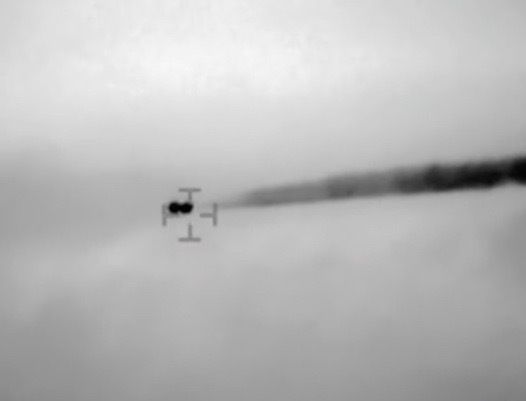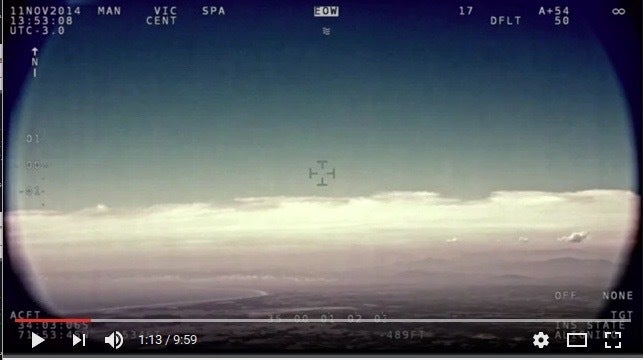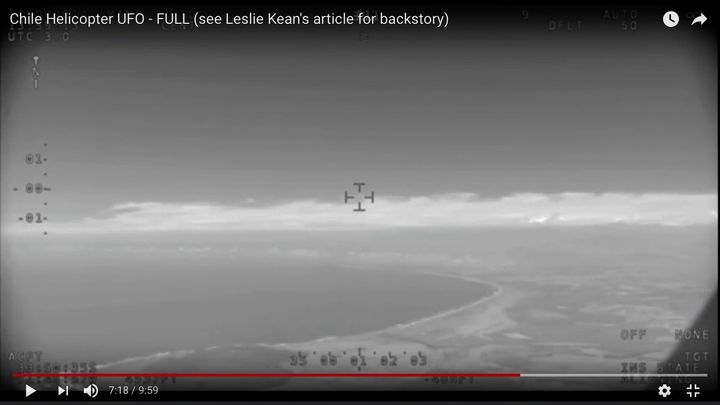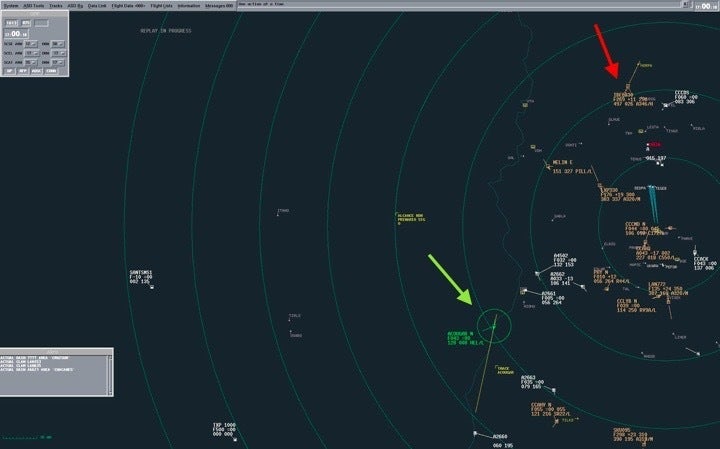Since its release on The Huffington Post on January 5, a video taken from a Chilean Navy helicopter of an unidentified object has gone viral, with almost two million views. (Please see my previous story for necessary background.) I reported on the Chilean government CEFAA’s conclusion, based on the collective opinion of its many committee members, that the object was a UAP and could not have been an airplane. Since then, this has come into question, and has raised doubts in some people’s minds.
It is now becoming clear that this possibility is a legitimate one, and needs to be explored further. Scrutiny and debate are always a good thing, of course. But putting any conclusions about the case aside, my colleagues and I would like to suggest that a more scientific and respectful approach be taken than what we have seen so far, if further investigations are to be undertaken.
And, a note on the images included here: They are not to be reproduced anywhere without permission. The videos and photos from my previous story were taken and spread wildly around the internet. Also, many news outlets and blogs re-phrased the article or simply copied it outright, as if it were theirs, without giving credit to its source. This time, I am stating up front that these images belong to CEFAA and reproduction is strictly prohibited. Anyone is free to link to any story I write for The Huffington Post, but please do not steal its content!

A plume formed to the right of the object, at the end of the video. Could this be a plane? The CEFAA ruled out that possibility, but some critics are not convinced.
Since this widely distributed story broke, people using social media and blogs have taken it upon themselves to solve this case in a matter of days, and with minimal information. These platforms have presented arguments without properly developing them, and in some cases people with prior agendas have made derogatory, sometimes inaccurate statements that do not facilitate cooperative relationships between CEFAA and those seriously interested in the case.
The French IPACO study of 2015 made a start in the right direction, and it is vitally important that France and Chile, the only two governments with official UAP offices, work together. But this report is preliminary and may not have included all the data; for instance, it did not use the correct camera in its analysis. The French analysts did not have the radar at this time either, as far as I understand it.
The French conclusion, which CEFAA and its committee did not accept, stated that the object was a medium-haul plane coming in for a landing and dumping water. Dumping of any kind requires permission from ground control which directs the plane to a specific zone for this purpose, from where the pilot must report the start and finish of the operation. The IPACO study was not nearly enough to settle this case, and shows that further study would be beneficial.
Robert Powell, one of two authors of the radar/witness report on the 2008 Stephenville Lights case and the head of MUFON’s Science Review Board, contacted me right after the story broke, with a genuine interest in the case. As a member of The Scientific Coalition of Scientists for UFOlogy (SCU), a think tank of scientists and researchers, Powell co-authored the outstanding, detailed report on the 2013 Aguadilla Puerto Rico UAP video from the Department of Homeland Security, also captured with a FLIR camera on an aircraft shooting in infra red. He is more than qualified to study this case.
With CEFAA’s permission, I provided him with the radar tracking data. Powell verified that the time shown on the camera matches the time on the radar exactly, by synchronizing them while looking at the longitude and altitude of the helicopter. This timing is very precise, and it doesn’t allow wiggle room for data that may come close but doesn't fit. Let me share with you some interesting steps he took.


The location of the object in two stills from the video, as the helicopter moved up along the coast towards it.
Powell could tell from the radar that if the object were an airplane, the most likely candidate would be Flight IB6830, an Iberia Airlines four-engined A340, which has been discussed on the internet.
To examine this hypothesis, Powell noted the angle of the camera in relation to the helicopter, as indicated on the bottom of the video. According to the data there, it averages about nine degrees, pointing N/NE. This means the camera is pointing almost straight ahead, but is aimed about 9 degrees to the right of the helicopter. (I was in error when I wrote that the object was to the left of the plane and over the water in my previous story.) This angle determines the camera’s line of sight from the helicopter outwards. Any aircraft which was further East than the nine degree angle of the camera could not be captured in its viewfinder.
Powell then took various radar images which showed both the helicopter and IB6830, and measured the camera angle from the chopper with a protractor, marking it on the image. He then measured the angle of IB6830 in relation to the chopper. He discovered that IB6830 appeared to be at too wide an angle - too far to the east - to have been captured by the camera.
For example, the object first appears at 13:52:38 military time, as shown on the video. At this time on the radar (16:52:38 local time), one can measure that the angle of IB6830 to the chopper is 18 degrees. This means it is about nine degrees too far away to register in the viewfinder of the camera. Other frames on the radar indicate the same approximate angle.

Radar at 13:52:38 military time. The Cougar helicopter is designated by the green arrow, in a green circle, and flight IB6830 with the red arrow. The apparent angle of the camera relative to the Cougar prohibits the viewing of IB6830, which is too far to the right.

The Cougar and IB6830 when the plume first appeared, at 14:00:09 (17:00:18 on the radar).
Then, Rob Jeffs, a UK programmer with an interest in recorded radar data and how it relates to UAP, made some discoveries from the radar tracking images which challenge this simple, preliminary finding.
The plot of the chopper’s flight path is clearly shown on the radar, and it can be plotted using the altitude and longitude given on the video. The French IPACO flight path diagram in my previous article matches that on the radar.
Jeffs took images of the landscape from the video, like those shown above, and found a reference point on the coastline to approximate the absolute bearing of the camera at that time. Then on a map from google earth, he was able to align the chopper with IB6830 - which can be plotted based on the radar data - and see what the angle was between them. In doing so, Jeffs found an error in the azimuth reported by the video camera of about 7 degrees as compared to what he found using this approach.
When he added this “error” to the direction of the Cougar and plotted this against the flight path of IB6830, the path of IB6830 and the camera viewfinder align. In other words, if you add 7 degrees to what we thought the camera angle was, based from the data on the video, it looks like flight IB6830 is the object.

Above: Absolute magnetic bearing of the Cougar (red) with a correction of 7 degrees as compared to that of IB6830 (blue). Ignore the first point on the graph, as the object was not in view. It appears that the camera was not centered on the Cougar’s nose (azimuth of zero), but was offset by about 7 degrees, (inferred from an analysis of the video images of the coastline combined with radar data images).
On Google Earth, it can be determined that the helicopter is flying on a course of 17.4 degrees to true north. To round it off, let’s say the camera azimuth shows a bearing of ten degrees rather than nine. We would add this onto the helicopter's bearing (of 17.4) to get a total bearing of 27.4 It turns out that IB6830 is another 7 degrees (on average) on top of that, at 34.3 degrees.
The values are consistent along the pathways, just like they were for Powell. What are the chances that a plane could share the same path as the object, except for a 7 degree difference from how it was registered on the camera but not when plotted on google earth, and not be the object?
But does it make any sense that the camera’s measurement of it’s angle was off by 7 degrees? Perhaps it had not been set to zero at the beginning. Or, maybe there is a defect in the system. In fact, during the video, the camera's internal compass was not working or was turned off - it's not showing the cameras movement in relation to true north, as it should. And, nowhere is the helicopter's bearing of 17.4 degrees shown, as it should be. So, one possibility is that all the camera functions were not turned on. Was it a new camera that had not been put to full use yet? We don’t know the answer.
Jeffs also provided the following image and caption:

At 13:52:38, IB6830 is turning hard to starboard, to head north and probably banking. Distance from Cougar: 38 nautical miles
Many intriguing questions remain, calling any conclusion at this point into question. The Navy crew said the visibility from the Cougar was 30 nautical miles. Since the IB6830 was farther from that during much of the video, how could the camera have recorded it? And it is hard to imagine that the experienced pilot would not recognize an airplane.
If the camera was recording IB6830, why did it not record other planes that went across its path during those ten minutes? Why didn’t the on-board radar pick up the plane at any point? And, when IB6830 made a loop (visible in the radar images) after being spotted by the camera, why didn’t the camera have to change angles radically in order to follow it?
Work on the case has been developing and changing every day. It is time for me to bow out and leave this to the experts to sort out. I am not qualified to conduct any studies myself, but only to report on further findings when they become available.
So from here on out, I hope that those who wish to contribute to the further understanding of this case will present their findings in papers that can be studied properly, rather than in quick, superficial examinations on blogs or by issuing uninformed and disrespectful opinions on social media. We all have to step back for a while, because proper investigations take a long time.
And what about CEFAA? The staff there do not spend time putting together long reports after conducting an investigation, because this is not something that is needed for the work they do. They collect the data and rely on committee members from many disciplines to provide their views, which usually takes a long time. Much of the work is done during discussions at lengthy meetings. At the end, they simply move on. The agency is not a research organization. It is not mandated to provide reports for UFO investigators in other countries, nor does it have the time or interest to do so.
“Concerning our studied cases, we at CEFAA respect every opinion issued either by individuals or organizations as long as they are made in good faith and with serious knowledge to back them up,” Jose Lay, interim director of CEFAA, told me in a January 17 email.
Actually, I believe that the resolution of this video is of secondary importance. What’s more significant is the fact that, in Chile, a government agency investigates reports of UAP. It is setting an example for the rest of the world. There are already so many strong cases for which conventional explanations can be ruled out, but this has not solved the UFO problem. One more such case is not as newsworthy as the existence of the CEFAA, functioning in a country where the military, aviation, and scientific communities take this subject seriously and are open about it. That is the most important message I always attempt to provide here in America, whenever I write about CEFAA’s work.
“I commend the Chilean military for making the video and radar public,” says Powell. “I had no success in getting such data from the American military while investigating Stephenville, and we are supposed to be a free country.” We must not forget the importance of what CEFAA is doing, regardless of the outcome of any specific case.